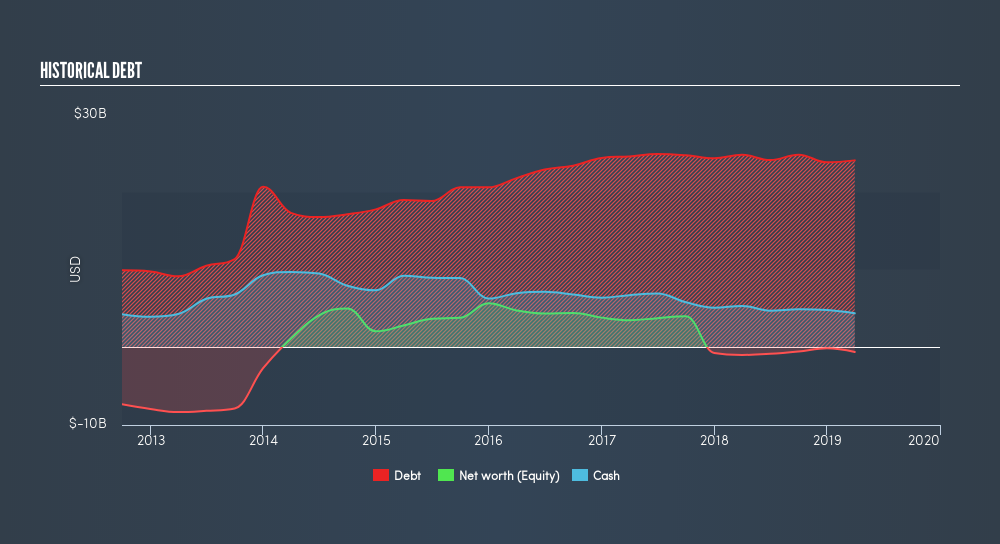- United States
- /
- Airlines
- /
- NasdaqGS:AAL
Does American Airlines Group (NASDAQ:AAL) Have A Healthy Balance Sheet?

Want to participate in a short research study? Help shape the future of investing tools and you could win a $250 gift card!
The external fund manager backed by Berkshire Hathaway's Charlie Munger, Li Lu, makes no bones about it when he says 'The biggest investment risk is not the volatility of prices, but whether you will suffer a permanent loss of capital.' It's only natural to consider a company's balance sheet when you examine how risky it is, since debt is often involved when a business collapses. As with many other companies. American Airlines Group Inc. (NASDAQ:AAL) makes use of debt. But the more important question is: how much risk is that debt creating?
When Is Debt A Problem?
Generally speaking, debt only becomes a real problem when a company can't easily pay it off, either by raising capital or with its own cash flow. Part and parcel of capitalism is the process of 'creative destruction' where failed businesses are mercilessly liquidated by their bankers. However, a more usual (but still expensive) situation is where a company must dilute shareholders at a cheap share price simply to get debt under control. Of course, the upside of debt is that it often represents cheap capital, especially when it replaces dilution in a company with the ability to reinvest at high rates of return. The first thing to do when considering how much debt a business uses is to look at its cash and debt together.
View our latest analysis for American Airlines Group
What Is American Airlines Group's Net Debt?
As you can see below, American Airlines Group had US$24.0b of debt, at March 2019, which is about the same the year before. You can click the chart for greater detail. However, it does have US$4.35b in cash offsetting this, leading to net debt of about US$19.7b.

A Look At American Airlines Group's Liabilities
According to the last reported balance sheet, American Airlines Group had liabilities of US$19.8b due within 12 months, and liabilities of US$41.6b due beyond 12 months. Offsetting these obligations, it had cash of US$4.35b as well as receivables valued at US$1.88b due within 12 months. So it has liabilities totalling US$55.2b more than its cash and near-term receivables, combined.
The deficiency here weighs heavily on the US$14.5b company itself, as if a child were struggling under the weight of an enormous back-pack full of books, his sports gear, and a trumpet. So we'd watch its balance sheet closely, without a doubt At the end of the day, American Airlines Group would probably need a major re-capitalization if its creditors were to demand repayment. Because it carries more debt than cash, we think it's worth watching American Airlines Group's balance sheet over time.
We use two main ratios to inform us about debt levels relative to earnings. The first is net debt divided by earnings before interest, tax, depreciation, and amortization (EBITDA), while the second is how many times its earnings before interest and tax (EBIT) covers its interest expense (or its interest cover, for short). Thus we consider debt relative to earnings both with and without depreciation and amortization expenses.
American Airlines Group's debt is only 3.38 times its EBITDA, and its EBIT cover its interest expense 3.86 times over. This suggests that while the debt levels are significant, we'd stop short of calling them problematic. Worse, American Airlines Group's EBIT was down 27% over the last year. If earnings keep going like that over the long term, it has a snowball's chance in hell of paying off that debt. The balance sheet is clearly the area to focus on when you are analysing debt. But it is future earnings, more than anything, that will determine American Airlines Group's ability to maintain a healthy balance sheet going forward. So if you're focused on the future you can check out this free report showing analyst profit forecasts.
Finally, a business needs free cash flow to pay off debt; accounting profits just don't cut it. So it's worth checking how much of that EBIT is backed by free cash flow. Over the last three years, American Airlines Group recorded negative free cash flow, in total. Debt is usually more expensive, and almost always more risky in the hands of a company with negative free cash flow. Shareholders ought to hope for and improvement.
Our View
To be frank both American Airlines Group's EBIT growth rate and its track record of staying on top of its total liabilities make us rather uncomfortable with its debt levels. And furthermore, its net debt to EBITDA also fails to instill confidence. Considering all the factors previously mentioned, we think that American Airlines Group really is carrying too much debt. To us, that makes the stock rather risky, like walking through a dog park with your eyes closed. But some investors may feel differently. Given our concerns about American Airlines Group's debt levels, it seems only prudent to check if insiders have been ditching the stock.
If you're interested in investing in businesses that can grow profits without the burden of debt, then check out this free list of growing businesses that have net cash on the balance sheet.
We aim to bring you long-term focused research analysis driven by fundamental data. Note that our analysis may not factor in the latest price-sensitive company announcements or qualitative material.
If you spot an error that warrants correction, please contact the editor at editorial-team@simplywallst.com. This article by Simply Wall St is general in nature. It does not constitute a recommendation to buy or sell any stock, and does not take account of your objectives, or your financial situation. Simply Wall St has no position in the stocks mentioned. Thank you for reading.
About NasdaqGS:AAL
American Airlines Group
Through its subsidiaries, operates as a network air carrier in the United States, Latin America, Atlantic, and Pacific.
Good value with reasonable growth potential.
Similar Companies
Market Insights
Community Narratives



